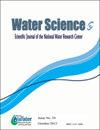Aquifer potential of the transboundary crystalline-sedimentary complexes: from Northcentral Nigeria to Northwestern Cameroon border
Q2 Environmental Science
引用次数: 0
Abstract
ABSTRACT The aquifer system was apparently hidden but has been revealed as linked to transboundary aquifers; hence, additional info for data update of the International Groundwater Resources Assessment Center (IGRAC). The aquifer was explored for the purpose of Internationally Shared Aquifer Resource Management (ISARM). It advanced from fractured aquifers at upstream to the multilayered aquifer system toward downstream. The watershed was explored from Northcentral Nigeria to Cameroon border with electrical sounding. Geological/Hydrogeological details were locally concentrated at the center of the watershed via drilling program, aquifer tests, and hydrological modeling. Aquifer stress index (AQSI) of the region was reviewed from the existing global dataset. Results revealed aquifer provenances from crystalline and sedimentary complexes. The aquifers were relatively inferred at third and fourth geoelectrical layers at upstream and downstream, respectively. Generally, drilling operation showed depth as ≥50.0 m. Most boreholes showed drawdown of ≤5.0 m and transmissivity of ≥100 m2/day, signifying the prolific nature of the aquifer system and enormous groundwater recharge. The AQSI ≤ 0.1 signified a stress-free aquifer. Concentrations of solutes are within nutritional background, yet moderately hard with bicarbonate/carbonate concentrations that can degrade the irrigation quality. Precipitates (CaCO3) from limestone provenance may hamper borehole yields at downstream alluvium. Thus, injection of gypsum at the groundwater recharge zones is a certified remedial.跨界结晶-沉积复合体的含水层潜力:从尼日利亚中北部到喀麦隆西北部边界
含水层系统似乎是隐藏的,但已经揭示了与跨界含水层的联系;因此,为国际地下水资源评估中心(IGRAC)的数据更新提供了额外的信息。为了国际共享含水层资源管理(ISARM)的目的,对含水层进行了勘探。它由上游的裂缝性含水层向下游的多层含水层推进。从尼日利亚中北部到喀麦隆边境的分水岭用电测深进行了勘探。地质/水文地质细节通过钻井程序、含水层测试和水文建模在流域中心局部集中。利用现有的全球数据集对该地区的含水层应力指数(AQSI)进行了回顾。结果表明,含水层物源来自结晶和沉积复合体。在上游和下游的第3层和第4层相对推断出了含水层。一般钻井作业深度≥50.0 m。大多数钻孔降深≤5.0 m,透过率≥100 m2/d,表明含水层系统的丰富性和巨大的地下水补给。AQSI≤0.1为无应力含水层。溶质浓度在营养背景范围内,但碳酸氢盐/碳酸盐浓度适中,会降低灌溉质量。来自石灰岩的沉淀物(CaCO3)可能会阻碍下游冲积层的钻孔产量。因此,在地下水补给区注入石膏是一种有效的补救措施。
本文章由计算机程序翻译,如有差异,请以英文原文为准。
求助全文
约1分钟内获得全文
求助全文

 求助内容:
求助内容: 应助结果提醒方式:
应助结果提醒方式:


